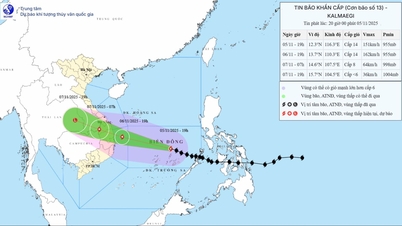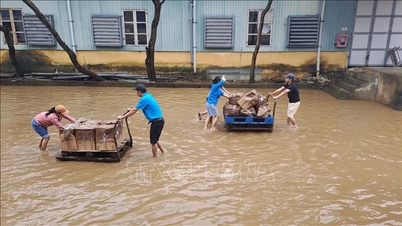
The cold spell over the past week with prolonged rain and humidity has caused an increase in the number of adults and children with flu. According to the National Children's Hospital, from the beginning of October 2025 to the morning of November 3, 2025, the total number of seasonal flu cases was 3,726, of which 479 children had to be hospitalized for treatment.
In just one week, from October 27 to November 2, there were 1,518 cases of flu, 169 children were hospitalized, many of whom had to be hospitalized due to complications such as pneumonia, otitis media, and febrile convulsions. This is something that families must pay close attention to in order to protect their families.
Disease prevention from home
According to Dr. Nguyen Huy Hoang, member of the Vietnam Association of Underwater and Hyperbaric Oxygen Medicine, the cold season in the North has two completely different “faces”. The harsh and erratic changes in the weather in the North are the reason why the body is vulnerable if there is no method to protect the family properly.
The early and mid-winter period, from November to January, is dry and cold: temperatures drop, but humidity also drops below 40%. This cold causes the skin, nasal mucosa, throat and respiratory tract to become dehydrated and cracked, weakening the body's natural "protective barriers", creating conditions for viruses and bacteria to invade.
Many people suffer from sore throat, rhinitis, and flu simply because of the lack of humidity in the air. The skin also “evaporates” water continuously, the lipid barrier is broken, leading to cracking, itching, and even secondary infection.
Therefore, Dr. Hoang said, the most important strategy during the dry season is to “preserve the barrier.” Each family should maintain the humidity in the house at 45 to 55% with a humidifier, drink enough warm water, and rinse the nose with saline to clean the mucous membranes. These are simple but effective measures that significantly reduce dry throat, stuffy nose and early-season flu.

From February to April, the North enters a humid period, a completely different type of cold. Humidity is often above 85%, the surface of the house "sweats", creating conditions for mold and dust mites to grow. Humid air also makes virus particles last longer, increasing the risk of infection with flu, colds, and pneumonia. This is the time when patients with allergies, asthma or COPD (chronic obstructive pulmonary disease) often have severe relapses.
At this time, according to Dr. Hoang, the goal of disease prevention has shifted to "reducing the pathogen load." Instead of humidifying, a dehumidifier should be used to reduce the humidity in the house to 50 to 60%.
In addition, people need to open the windows 2-3 times a day, dry damp surfaces, wash and dry bedding and curtains. Some families can use an air purifier with a HEPA filter to remove fine dust and allergens suspended in the air.
Whether dry or humid, the most dangerous factor is still the cold and sudden changes in temperature. When the body is exposed to cold, the sympathetic nervous system immediately reacts such as blood vessels constricting, blood pressure skyrocketing, blood becomes thicker, the heart has to work harder to keep the central organs warm.
Colds, flu and pneumonia are often confused.
According to Dr. Hoang, nowadays, families often see sneezing and runny noses and do not know if they have a cold or flu. Therefore, this expert points out some signs to help families gain more knowledge about disease prevention.
Accordingly, colds start slowly with sneezing, runny nose, mild sore throat; seasonal flu comes suddenly, high fever, body aches; while pneumonia is a dangerous complication, often occurring after a few days of seemingly recovering from the flu, with high fever returning, coughing up thick phlegm, chest pain and difficulty breathing. The elderly can have pneumonia without fever, only feeling tired, lethargic or not eating, signs that absolutely should not be ignored.
Influenza and many other respiratory viruses spread rapidly through droplets and hands touching the T-zone (eyes, nose, mouth), the main gateway for viruses to enter the body. Seasonal influenza can lead to many dangerous complications if not detected and treated promptly.
Therefore, doctors recommend that everyone should minimize the habit of touching their face and strictly wash their hands regularly with soap or antiseptic solution.
Parents need to pay special attention to children who are at risk of severe illness, dangerous signs that require taking the child to the hospital immediately, and know how to care for the child at home in mild cases.
Accordingly, the group of children who are most likely to become seriously ill when infected with seasonal flu are children under 5 years old, especially children under two years old; those with other chronic diseases; those with immunodeficiency; those who get sick twice in a month or whose illness has subsided but whose fever returns.
When you see your child has a high fever of over 39 degrees Celsius that does not respond to antipyretics or has convulsions; difficulty breathing, rapid breathing or abnormal breathing; severe chest pain or muscle pain; purple lips and extremities, cold hands and feet; lethargic, tired, poor appetite and vomiting a lot, you must take your child to the hospital promptly.
In the elderly, pneumonia is sometimes very "silent". Symptoms may not be high fever or severe cough, but only confusion (suddenly not recognizing relatives), unusual fatigue, or poor appetite. These are dangerous signs that require medical attention.
Vaccination is a scientific "shield". Families should pay attention to annual flu vaccination (for all subjects over 6 months old) and pneumococcal vaccine (as prescribed for risk groups: people over 65 years old, people with chronic diseases) to significantly reduce the rate of hospitalization and serious complications.
Source: https://nhandan.vn/bao-ve-gia-dinh-khi-thoi-tiet-giao-mua-post920622.html





![[Photo] Opening of the 14th Conference of the 13th Party Central Committee](https://vphoto.vietnam.vn/thumb/1200x675/vietnam/resource/IMAGE/2025/11/05/1762310995216_a5-bnd-5742-5255-jpg.webp)






















![[Photo] Panorama of the Patriotic Emulation Congress of Nhan Dan Newspaper for the period 2025-2030](https://vphoto.vietnam.vn/thumb/1200x675/vietnam/resource/IMAGE/2025/11/04/1762252775462_ndo_br_dhthiduayeuncbaond-6125-jpg.webp)








































































Comment (0)